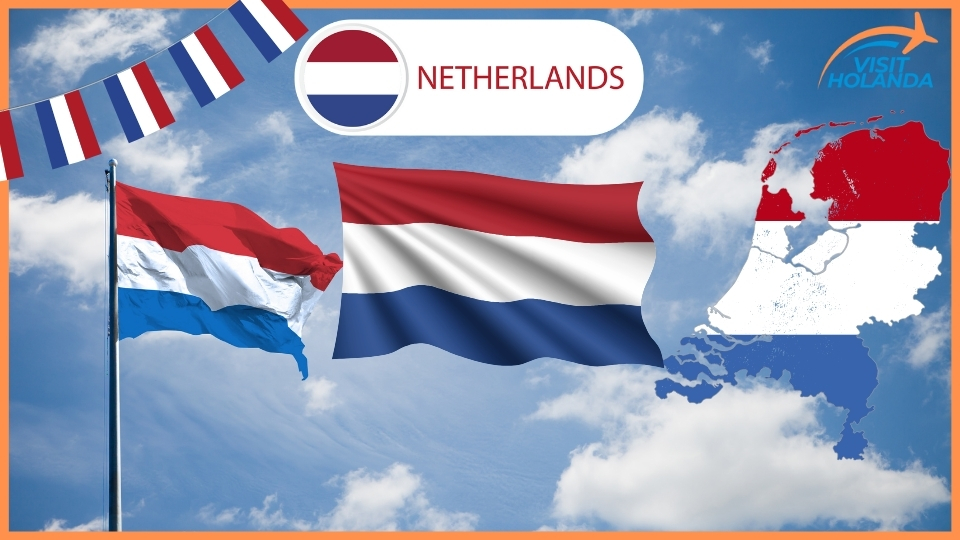The flag of the Netherlands, with its bold horizontal stripes of red, white, and blue, is among the most recognizable national flags in the world. It draws from centuries of history and reflects the rich heritage and indomitable spirit of the Dutch. The flag of the Netherlands forms a powerful symbol of unity, independence, and pride in belonging to the nation.
1. The History of the Dutch Flag
Origins of the Dutch Flag
The Dutch flag, as we know it today, has a long and storied history that dates back to the 16th century. Initially, the flag featured the colors orange, white, and blue, representing the coat of arms of William of Orange, the leader of the Dutch Revolt against Spanish rule. This original version, known as the “Prince’s Flag,” was flown during the Eighty Years’ War, symbolizing the fight for independence.
Evolution Over the Centuries
As the years progressed, the flag underwent several transformations. By the mid-17th century, the orange stripe was replaced with red, and the modern version of the flag, consisting of red, white, and blue horizontal bands, was officially adopted. This color change is believed to have been influenced by the difficulty in producing a consistent shade of orange with the dyes available at the time.
2. The Symbolism Behind the Colors
Meaning of the Red, White, and Blue Stripes
The colors of the Dutch flag each hold deep meaning. The red stripe symbolizes the people and their strength, the white stripe represents peace and honesty, and the blue stripe reflects loyalty, vigilance, and perseverance. These colors have become a proud symbol of Dutch identity and resilience throughout the nation’s history.
Comparisons to Other National Flags
The Dutch flag bears some resemblance to the flags of other countries, notably France and Russia. The horizontal stripes and color scheme have led to comparisons, though each flag has its unique history and symbolism.
3. Design and Specifications
Official Dimensions and Color Codes
The Dutch flag is a simple yet elegant design consisting of three equal horizontal bands of red, white, and blue. The official proportions of the flag are 2:3, with the red stripe on top, white in the middle, and blue on the bottom. The colors are defined by the NEN (Dutch Standards) as follows: red (vermillion), white, and cobalt blue.
How the Flag is Used Today
In modern times, the flag is flown across the country during national celebrations, government events, and international sporting competitions. It is also a common sight at Dutch embassies worldwide, symbolizing the Netherlands’ presence on the global stage.
4. The Role of the Flag in Dutch Culture
National Holidays and the Flag
On significant national holidays such as King’s Day (Koningsdag) and Liberation Day (Bevrijdingsdag), the Dutch flag is prominently displayed throughout the country. These occasions celebrate Dutch history, culture, and the monarchy, with the flag acting as a unifying symbol for all citizens.
The Flag’s Importance in Dutch National Identity
The Dutch flag is more than just a piece of cloth; it is a potent symbol of national identity. It embodies the values of freedom, democracy, and unity that the Dutch people hold dear, and it serves as a reminder of the sacrifices made during the struggle for independence.
5. The Influence of William of Orange
Historical Context of William’s Contribution
William of Orange, also known as William the Silent, played a pivotal role in the creation of the Dutch Republic. His leadership during the Eighty Years’ War laid the foundation for the Dutch independence movement, and the colors of the original Prince’s Flag were derived from his coat of arms.
The “Prince’s Flag”
The Prince’s Flag, with its orange, white, and blue stripes, was a powerful symbol of the Dutch revolt against Spanish rule. Although the modern Dutch flag no longer features orange, William of Orange’s legacy continues to influence Dutch culture and history.
6. Key Moments in Dutch History Involving the Flag
The Eighty Years’ War
The Eighty Years’ War (1568–1648) was a pivotal conflict that shaped the future of the Netherlands. The Prince’s Flag, flown during this time, became a symbol of the Dutch fight for freedom. By the end of the war, the Dutch Republic had gained its independence, and the flag evolved into its current form.
Dutch Independence and the Role of the Flag
The flag’s association with independence continued after the end of the war. It became a central symbol of the Dutch nation and has been displayed during key moments of national pride and unity ever since.
This flag represents not just an identifying symbol but a reflection of the rich history, values, and national identity that the country nurtures. From its roots in the Eighty Years’ War to modern displays in celebration, the red, white, and blue tricolor stands for strength, unity, and the perseverance of the Dutch people. Whether flown during national holidays, royal events, or international forums, the flag remains a powerful symbol of the Netherlands’ past, present, and future.
FAQs
What is the significance of the red, white, and blue colors of the Dutch flag?
The red represents strength, the white stands for peace and honesty, and the blue symbolizes loyalty and perseverance.
Why did the Dutch flag change from orange to red?
The orange dye was inconsistent, and over time, the red stripe became a more practical choice.
Is the Dutch flag flown differently on specific occasions?
Yes, the flag is flown on national holidays like King’s Day and Liberation Day.
How does the Dutch flag differ from the flags of France and Russia?
While the flags share similar colors, the Dutch flag has horizontal stripes, whereas France’s and Russia’s flags feature vertical stripes.
What are the dimensions of the Dutch flag?
The flag has a proportion of 2:3, with three equal horizontal bands.
What is the historical connection between William of Orange and the Dutch flag?
William of Orange inspired the original Prince’s Flag, which later evolved into the current flag.

